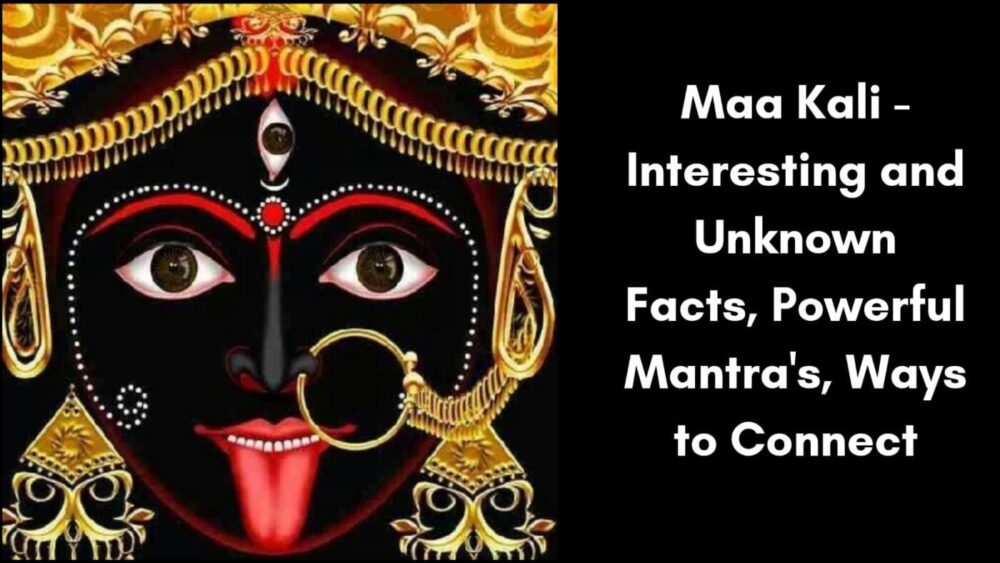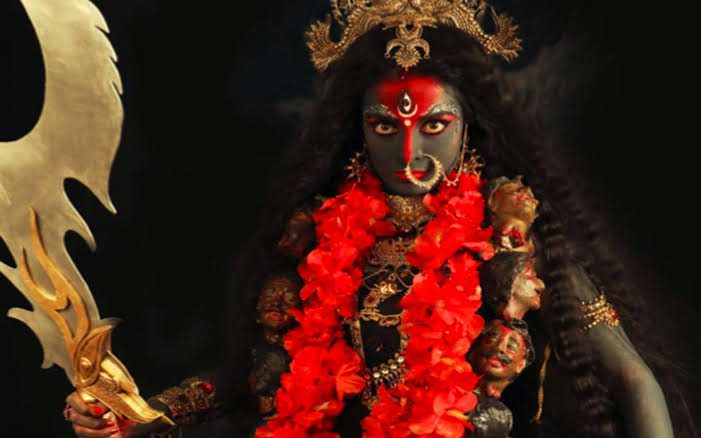Kali is known as Kālikā is a Ferocious Hindu Goddess. The name Kali means Kala or force of time. She is the feminine form of “time” or “the fullness of time”. She is the incarnation of Maa Parvati, wife of Lord Shiva. Maa Kali possesses immense power that no one can even weigh. She is also known as the “Dark Mother,” the Hindu Goddess of creation, preservation, and destruction. She is the fire of truth, not hidden by the trappings of ignorance. She is also regarded as a Goddess who is above nature and will continue to exist even after the universe ends. This article is focused to bring out the Interesting and Unknown Facts, Powerful Mantra’s, Ways to Connect with the most intense form of the Hindu Goddess.
Interesting and Unknown Facts about Maa Kali –
1. The Goddess Of ‘Kaliyuga’
Maa Kali is termed as the Goddess of Kaliyuga. As Kaliyuga “Kaliyuga” simply means extreme of Evil Activities and Negativities; it is believed that Maa Kali protects and gives power, strength, and wisdom to the devotees who worship her with true heart to fight against the evils of Kaliyuga.
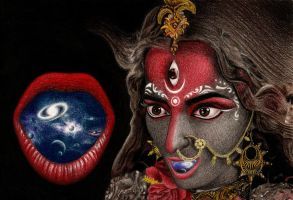
2. Magnificent Black Beauty
The Mahanirvana Tantra defines the Beauty of Maa Kali in a line that says: “Just as all colors disappear in black, so all names and forms disappear in her”. She is considered as the most magnificent black beauty. Her dark complexion symbolizes her embracing and transcendental nature. It also represents the womb of existence.
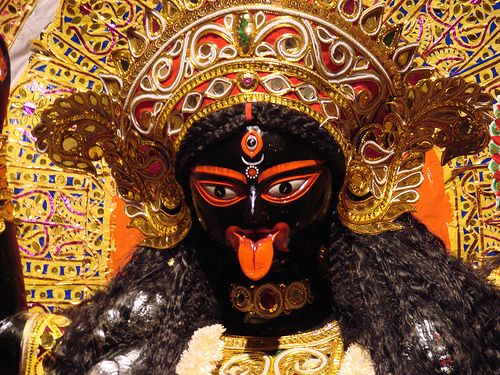
3. Depiction Of Maa Kali
She is portrayed naked to epitomize that she is pure and completely beyond the covering of Maya. She is pure (Nirguna) being-consciousness-bliss. It is believed that concepts such as color, light, good, bad do not apply to her as she is the pure, un-manifested energy, the Adi-shakti.
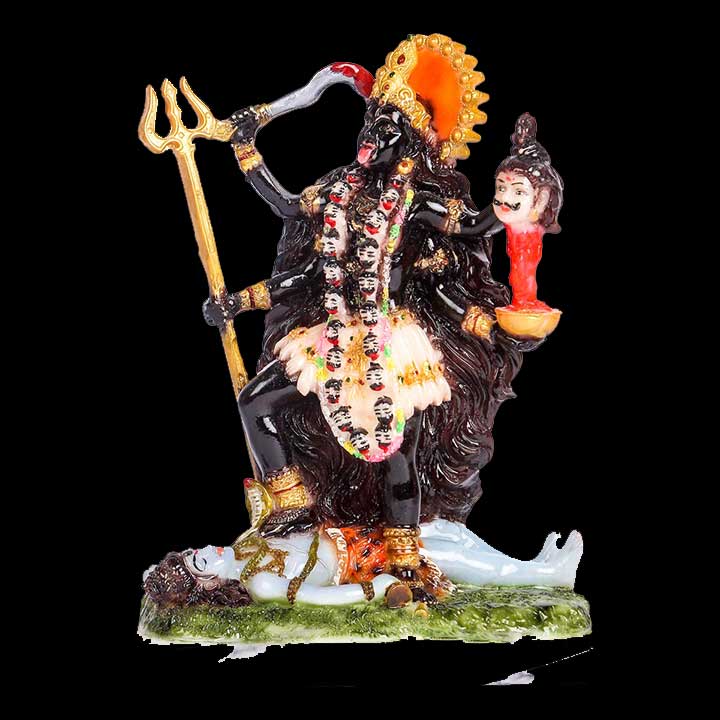
4. Appearance of Maa Kali
Maa Kali is seen wearing a garland of human heads, a skirt of arms, lolling tongue and a knife dripped in blood. The garland of Human heads is enumerated at 108 (an fortunate number in Hinduism and the number of countable beads on a Japa Mala) or 51, which represents Varnamala or the Garland of letters of the Sanskrit alphabet, Devanagari. It is believed that Sanskrit is a language of dynamism, and each of these letters represents a form of energy, or a form of Kali. Hence, she is also considered as the mother of language, and all mantras.
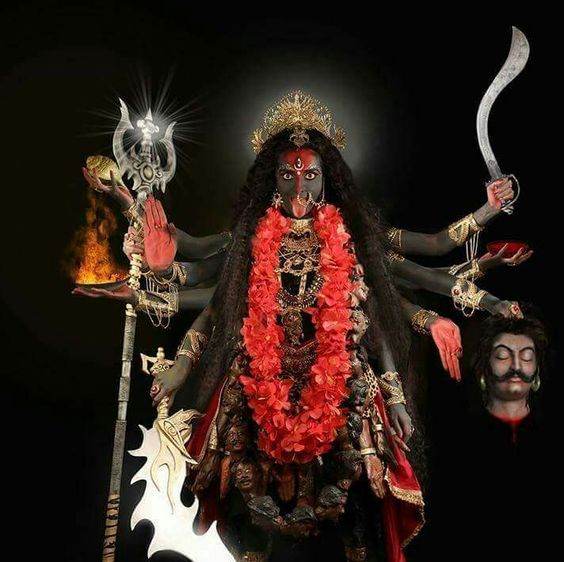
5. Most Misunderstood Goddess
Maa Kali is often thought of as something to be afraid of: a goddess of death and violence. Just because of her complexion, intense appearance, and fierce attitude there are various misunderstandings in the minds of people as they consider her as a goddess dark of mind, body and soul, a mysterious goddess of death and destruction. NO, Maa Kali isn’t about death or evil. She is about transformation; she is the goddess of destroying the evil and their evil forces for the protection of the innocent ones.
6. Killing Of Raktabija
According to the eighth chapter of Devi Mahatmya from Markandeya Puran, there was a demon named Raktabija (blood-seed) who had a boon from Lord Brahma that every time a drop of his blood fell on the ground, his strength would increase many times, by his blood creating more of his own. Because of the boon he considered himself the most powerful and started to make people’s life hell and caused destruction. All the Gods were troubled by this and they decided to work together and combine all of their Shakti or Divine energy and produce one super being that could destroy Raktabija; and the result was Maa Kali. Maa Kali fought and defeated Raktabija with many hands and an outstretched tongue with which she drank the blood of the monster stopping him to multiply. It was his severed heads that Kali wears as a garland even today.
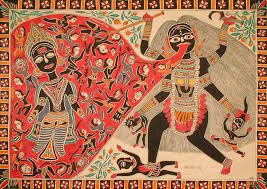
7. Forms Of Maa Kali
It is said that Maa Kali has 8, 12, or 21 different forms according to different traditions. Maa Kali is portrayed mainly in two forms: the popular four-armed form and the ten-armed Mahakali form. She is portrayed shining like a blue stone in the Mahakali form with ten faces, ten feets and three eyes on each face. There is no association with Lord Shiva in this form. The popular form of Kali Worshipped in Bengal is Dakshina Kali, Raksha Kali (form of Kali worshipped for protection against epidemics and drought), Bhadra Kali and Guhya Kali. Other popular forms are Adya kali, Chintamani Kali, Sparshamani Kali, Santati Kali, Siddhi Kali, Bhadra Kali, Smashana Kali, Adharvana Bhadra Kali, Kamakala Kali, Guhya Kali, Hamsa Kali, and Kalasankarshini Kali.
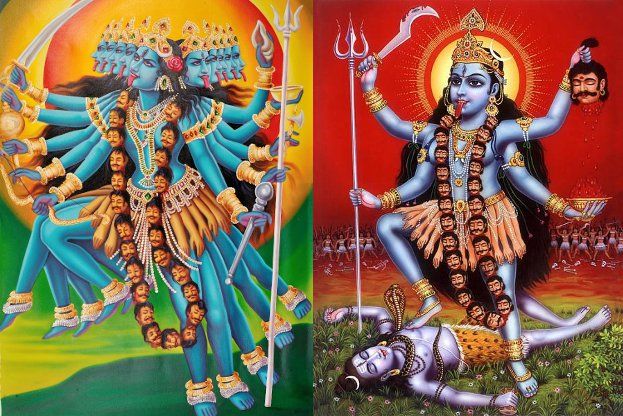
8. The Dakshina Kali Pose
This is the most popular form of Maa Kali worshipped in Bengal. It is said that Kali, becoming drunk on the blood of her victims on the battlefield starts dancing with destructive frenzy. She becomes forceful and unstoppable by any God and is about to destroy the whole universe. After urged by all the gods, Shiva lies in her way to stop and calm her. In her fury, she fails to see the body of Shiva lying amongst the corpses on the battlefield and steps upon his chest. When she realizes Shiva lies beneath her feet, her anger is pacified, and she calm down. Maa Kali was ashamed of the fact of keeping her husband beneath her feet and thus stuck her tongue out in shame.
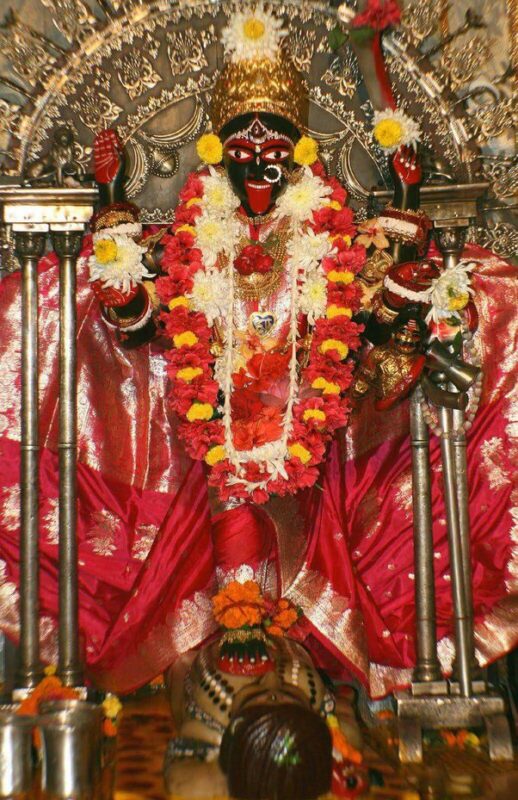
9. The Significance of her Four Hands
Among the four hands, two hands of Maa Kali Symbolizes demolishment and destruction of evils. The other two hands symbolize her pure love, affection and benevolence towards her children or devotees.
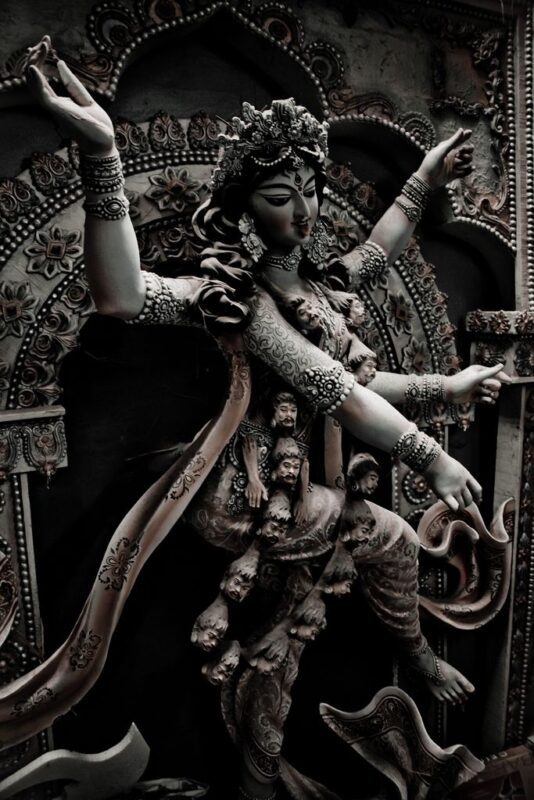
10. The Third Eye of Maa Kali
The signs of Sun, Moon and Fire which represent the driving forces of nature are visible under the third eye of Maa Kali. She evolved to a complete symbol of Mother Nature in her creative, nurturing, and devouring aspects. She is also worshipped as the Preserver of nature.
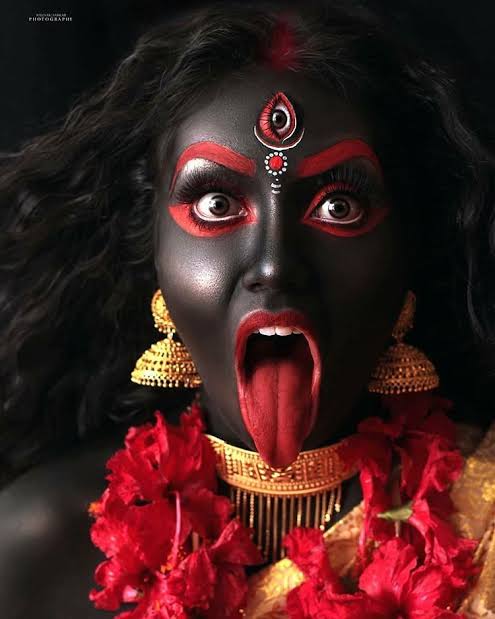
11. Maa Kali in Bengali Tradition
Maa Kali is worshipped in Bengal for many centuries. She is a central figure in late medieval Bengali devotional literature. The unique and powerful tradition of songs to Kali began in the eighteenth century with the poet Ramprasad Sen. The popular poets used to follow mystical yoga practises to feel the presence of Maa Kali and then write their heart out in their poetry and songs dedicated to her. The endearing mother-and-child idiom established by poets like Ramprasad Sen and his close contemporary Kamalakanta Chakravarti attracted many later poets to the genre. A part of Bengali Devotional Music that features Maa Kali as its central theme is known as Shyama Sangeet. Two great composers of Kali Songs are Rabindranath Tagore and Kazi Nazrul Islam.
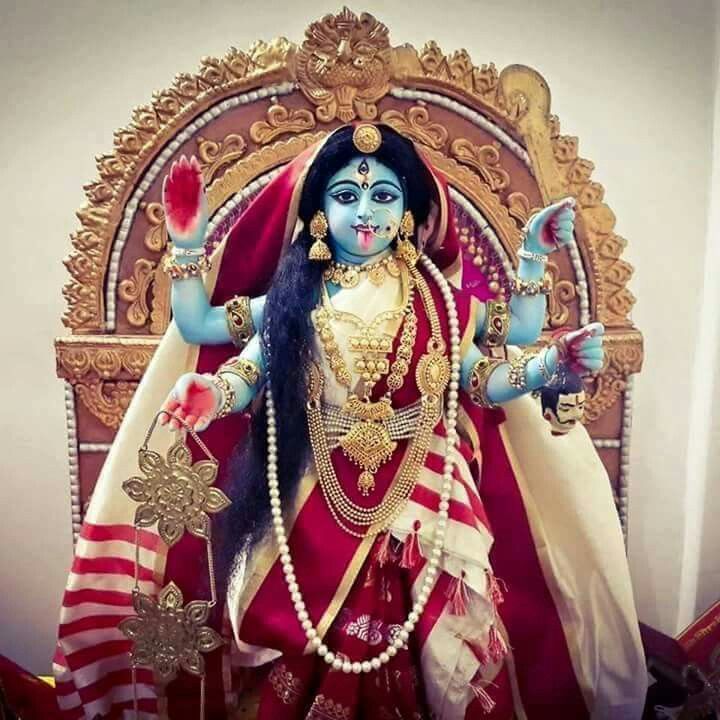
12. The Tantric Interpretation Of Maa Kali standing up on Lord Shiva
The Tantric Interpretation Of Maa Kali standing up on Lord Shiva gives a new perspective of the pose. The interpretation is as follows: “The Shiv tattava (Divine Consciousness as Shiva) is inactive, while the Shakti tattava (Divine Energy as Kali) is active. Shiva and Kali depict Brahman, the Absolute pure consciousness which is beyond all names, forms and activities. Kali, on the other hand, portrays the potential (and manifested) energy responsible for all names, forms and activities. She is his Shakti, or creative power, and is seen as the substance behind the entire content of all consciousness. She can never exist without Shiva or act independently of him, just as Shiva remains a mere corpse without Kali i.e., Shakti, all the matter/energy of the universe, is not distinct from Shiva, or Brahman, but is rather the dynamic power of Brahman. Thus, Kali is Para Brahman in the feminine and dynamic aspect while Shiva is the male aspect and steady. She stands as the absolute basis for all life, energy and beneath her feet lies, Shiva, a metaphor for mass, which cannot retain its form without energy”.
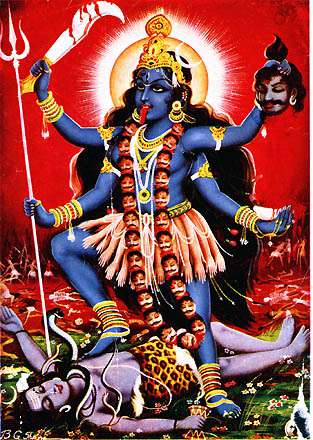
Powerful Maa Kali Mantra’s
1. “Om Kring Kalikaye Namah”
This mantra transforms the devotee to pure consciousness.
2. “Om Klim Kalika-Yei Namaha”
This is the Kalika-Yei mantra. Chanting this mantra is said to bring relief from all kinds of problems, no matter how complex it is.
3. “Om Hrim Shreem Klim Adya Kalika Param Eshwari Swaha”
This is the Fifteen syllable mantra. It is believed that chanting this mantra brings quick growth to one’s spirituality.
4. “Om Maha Kalyai
“Ca Vidmahe Smasana Vasinyai
Ca Dhimahi Tanno Kali Prachodayat”
This is the Kali Gayatri Mantra. The meaning of the mantra is ‘Om Great Goddess Kali, the One and only one, who resides in the Ocean of Life and in the Cremation Grounds that dissolve the world. We focus our energies on you, may you grant us boons and blessings’.
5. “Om karala-badanam ghoram mukta-kEshim chatur-bhuryam.
kalikam dakshinam dibyam munda-mala bibhushitam
sadya-chinna shira kharga bama-dordha karambujam
abhayam baradan-chaiba dakshina-dardha panikam”
This is the Dakshina Kali Mantra which is also called as Karpuradi Strotam. This mantra means ‘Om. Fierce of face, she is dark, with flowing hair and four-armed. Dakshina Kalika divine, adorned with a garland of heads. In Her lotus hands on the left, a severed head, and a sword. She bestows sanctuary and blessings with her right hands’.
Ways To Connect With Maa Kali
It is said that if you get struck in attachment, if you are afraid of anything, if you are struggling to vent out feelings or start something new you must call on Maa kali. There are various ways with which you can connect to Maa Kali, feel her, get peace of mind and get abundant blessings from her. Some of the ways are:
1. Close your eyes and chant the Kali Mantra’s regularly.
2. You can meditate with her image keeping it in front of you or just in your mind.
3. Place one palm to the centre of your heart and one palm towards belly and ask yourself what message Maa Kali has for you today. Sit in silence, breathe deeply and hold her image in your mind, and feel the vibrations.

